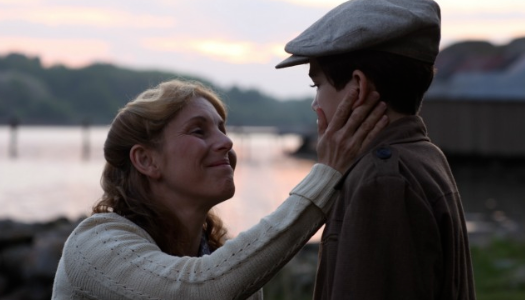
Directed by Lisa Ohlin
Written by Lisa Ohlin and Marnie Blok
Sweden, 2011
During the late 1930’s and early 1940’s, young Simon Larsson (Jonatan S. Washer) and his family live in the idyllic Swedish countryside. There, he and his father (Stefan Gödicke) are at constant odds, with Simon wanting to go to grammar school and his father wanting him to be a labourer. Isolated within his own home, Simon regularly takes refuge in his books, reading them while perched on a giant oak tree. Eventually, his father capitulates to his constant appeals, and at school, Simon meets Isak (Karl Martin Eriksson), the son of a wealthy Jewish bookseller (Jan Josef Liefers). As their friendship grows, and as the impending war looms, the two families come closer together, changing them in ways they’d never expect.
Saturated with the pastoral beauty of the Swedish countryside, and shot with careful and elegant poise, Simon and the Oaks is an outstanding visual achievement. Accompanied with a turbulent relationship between a disciplinary orthodox father and his emotionally defiant son, the film has all the trappings of becoming the Swedish version of The Tree of Life (there’s even a titular tree). As the relationship with his father slowly deteriorates, Simon takes solace with Ruben, Isak’s dad. More sophisticated and highbrow, Ruben and Simon share similar interests, with their relationship serving as a substitute for their own failed domestic affairs. In turn, Isak, who sees himself an artisan, begins to curry favour with Simon’s dad, Erik, who is likewise. This change in family and character dynamics becomes the crux of the film’s first half, creating potential for reciprocity and retribution, while concurrently challenging the notions of Nature versus Nurture.

This, however, also becomes the film’s apex. As the film moves past the halfway point and into the adulthood of the children, the film becomes operatic, no longer germane to its original strengths. Initially an ensemble piece, it gradually dissipates when established characters are shed from the story in order to focus more on the adult Simon (Bill Skarsgård). Characters, like the adult Isak (Karl Linnertorp), are ostensibly purged from the rest of the film. Because they are so integral to the formative first half, and because we invest so much time into their stories, their subsequent absence is perplexing. To compensate, new characters are introduced, but since they are tertiary and neither here nor there in relevancy, they serve as nothing more than distractions.
All of this is done to highlight Simon’s personal story and his quest for self-realization. However, as he grows older, Simon becomes more insolent and unlikeable, making his story arc difficult to care about. As a child, Simon was portrayed as the tortured artist living amongst derisive philistines, and as such, we sympathize. But as he grows older, he blossoms into a proudly bourgeois adult, the very same stuck-up, elitist snob his parents warned him not to be. For example, there is a scene where, in order to impress a girl, he pompously lambasts the Marxist ‘new revolutionaries’ at his school for demanding socialism while eating the fruits of labour of their capitalist parents. This is deeply ironic because Simon, who doesn’t work, lives with, and has his education paid by, his socialist parents.
What’s left is a story, which can be summed up as the byproduct of adding Toast with After the Wedding. Although set amongst the backdrop of World War 2 and the Holocaust, nothing about the central story demanded its inclusion as a necessity (even if it is faithful to the novel it was adapted from). The fact that it is included makes it feel like a manipulative storytelling device, which, along with the periodically indulgent violin symphonies, turns Simon and the Oaks into a melodramatic exercise.
Justin Li


